Frontline Renault Trafic – le camping car
Bonjour mes amies! C’est le moment pour le camping car review. If you are wondering about the Français introduction, I’ve been getting around in Frontline Campers’ latest pop-top campervan based on a Renault Trafic van.
I have some fond memories of the French vehicle manufacturer. On a visit to France some years ago, our hire vehicle was a hot little Renault hatchback with a manual gearbox. I’m okay with driving on the left but getting my right hand to do what my left hand has been doing for nearly 45 years took a few days.
Frontline’s new Renault Trafic is based on plenty of years of experience in the campervan conversion business, which Frontline certainly has. When I first checked over the Trafic, several features looked familiar – but the Renault added a new dimension. Frontline distinguishes its various models by the base vehicle, so there’s the Frontline Toyota HiAce, the Frontline Volkswagen; and, ta-da! the Frontline Renault Trafic.
LE DRIVE
When I picked up the Carmin Red (a very striking colour) Trafic, Frontline’s Gordon Galloway was enthusiastic about driving it, and I soon discovered why. It has frontwheel drive, is powered by a 2.0 litre turbo diesel engine and has a six-speed dual-clutch automatic transmission.
The idea of a dual-clutch transmission in a van seems odd, given they’re usually used in high-performance cars … but does this camper fly, or what? For the enthusiasts, a six-speed manual gearbox is also available. I didn’t have the vehicle long enough to get any fuel economy figures, but the Frontline team reckon it’s considerably better than the Hiace. On my little sojourn around the Blue Mountains west of Sydney, I had no reason to doubt that.
In the driver’s cab, all the controls and instrumentation were close to hand; even the sound system volume controls, once I discovered where they were. The centremounted touchscreen panel has the expected Apple CarPlay® and Android Auto® software and is very userfriendly. Around the cab, there are door pocket holders and cup/water bottle holders on top of the dashboard, but not much else apart from the good-sized pocket on top of the dashboard. It is large enough to hold a tablet or two and has two USB charger points for that very purpose. However, those same devices will be under the hot sun when driving along.

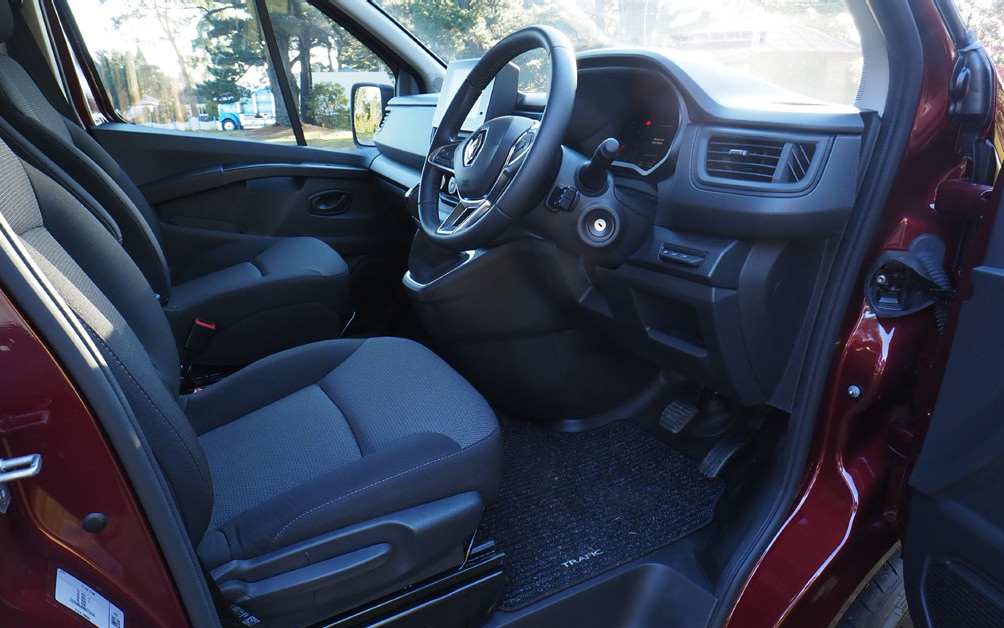
LE INTÉRIEUR
There are three layouts available with the Renault Trafic: The Vacationer, a two-seater with a walk-through; the Adventurer, a four-seater; and my review camper, an Adventurer Full Width, a four-seater with a full-width bed. The van itself has a sliding door and a rear lifting door. It’s also a flat floor layout, with easy access to and from the front cab seats. Adding to the rear layout is the passenger seat that swivels around. The rest of the layout is quite simple. There’s an offside kitchen bench and a day/night lounge seat that seats two when travelling and folds down into a bed.
Like most campers, the Trafic has a pop-top roof. It’s quite simple to elevate: just release the four corner
straps and push up. When the roof is raised, a removable shelf can be fitted across the air space in the rear. It’s a convenient feature for gear that might otherwise be stashed elsewhere when travelling. Large plastic boxes with lids are almost de rigueur in this style of camper.
There’s plenty of headroom and screened windows in the front and side walls of the gusset. In the van itself, there’s just one opening window on the offside. A couple of options fitted to my review van were zipped flyscreens for both the rear and sliding doors – an asset for sure. To get a bit more insect-free living space, there’s also the option of a flyscreen room for the Fiamma awning.
The plywood cabinetry in the Trafic is amazingly simple. Most of it in the Adventurer Full Width is fitted
along the mid-offside wall and forms up the kitchen cabinet. In addition to the induction hob, small stainlesssteel sink and 90 litre compressor fridge, there’s a range of small drawers and cupboards. There’s also a drawer under the rear seat for additional storage.
In the rear area, the platform and cushion form the bed at night but can be used for storage by day. Under the platform, the battery and battery management system take up part of the storage space.

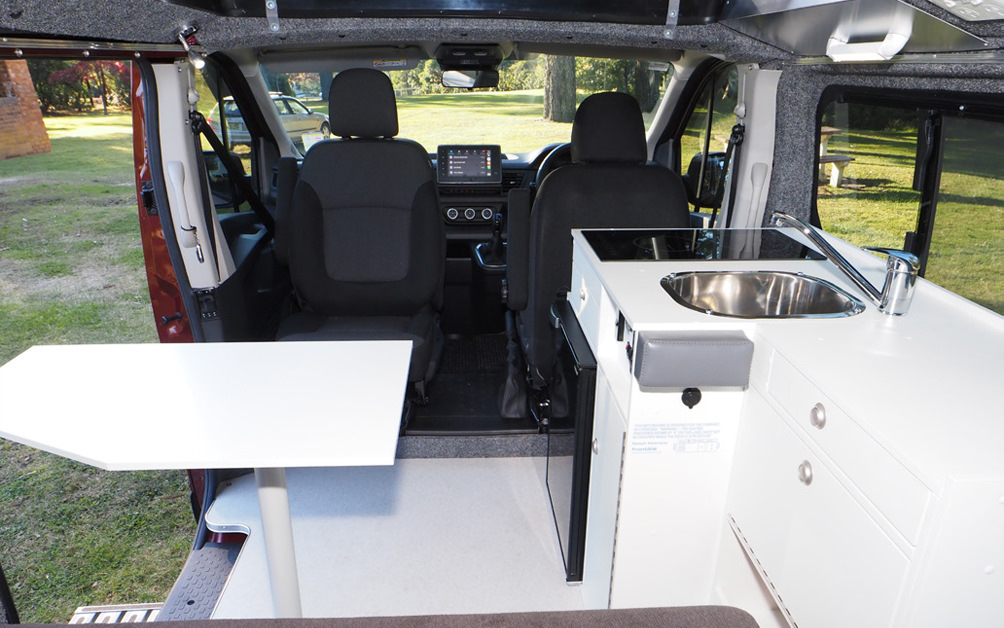
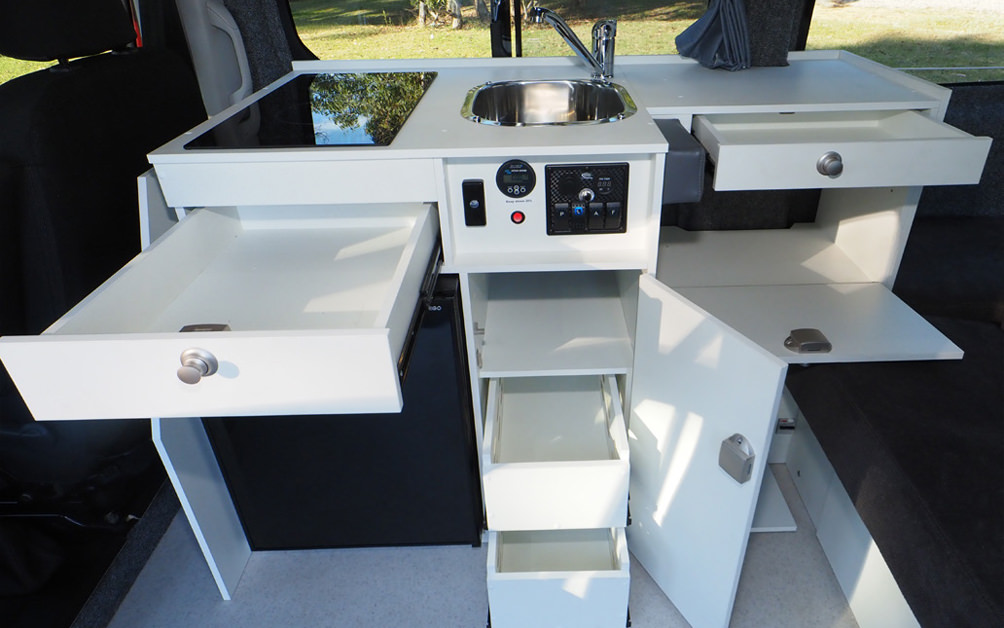

LA NUIT
The rear seat folds down very quickly and what this layout has is a bed with a length of 1.85m (6ft 1in). It’s 1.6m (5ft 3in) wide at the rear (pillow end) which narrows down to 1.17m (3ft 10in) at the foot end. The downside is the loss of offside cupboard space, which is a feature of the Adventurer layout. It means a narrower bed – but given the minimal storage space, I know what I would be opting for. A great feature of the rear seat is that it can be folded to face the rear. With a couple of cushions, it makes a great place to kick back and enjoy the view outside.
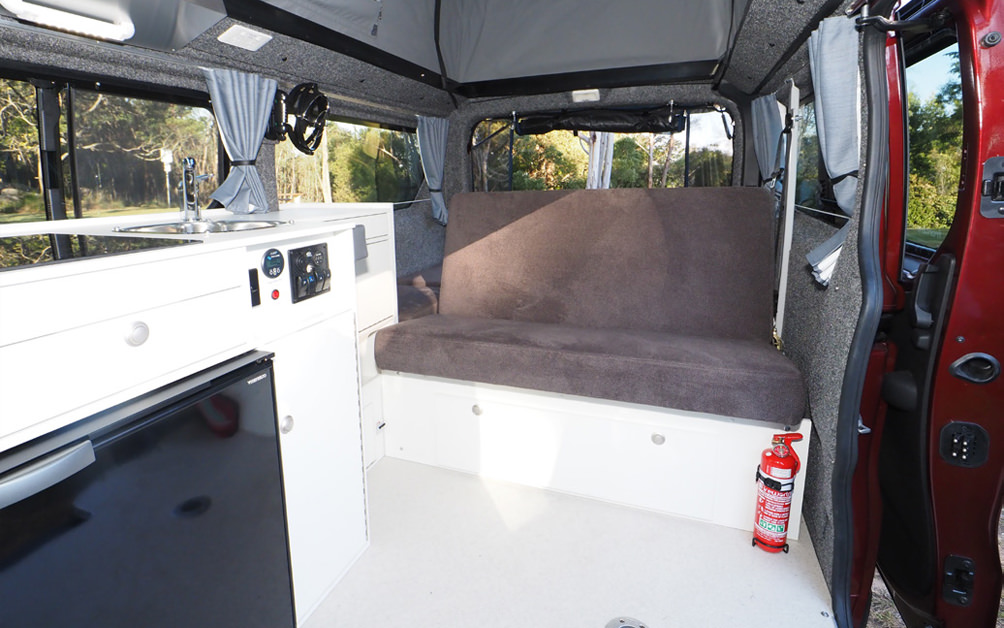
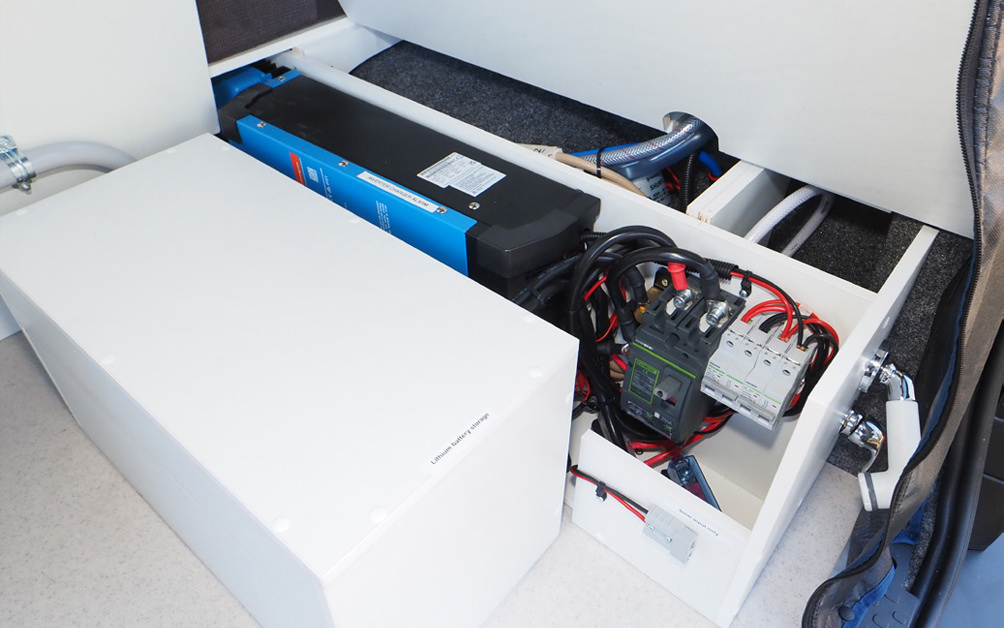



LE POWER SYSTÈME
The Trafic has a 100Ah AGM battery with a 25A charger in standard form. However, my review Trafic came with a 200Ah Lithium LiFePO4 battery, a 100W solar panel and a Victron Multiplus 2,000VA inverter/charger. This electrical package is designed to easily cope with the induction hob, compressor fridge, water pump and LED lighting. As long as some basic amenities are nearby when camped up, the Trafic is quite well equipped for off-grid travel.

LA CONCLUSION
latest is built very much in the accustomed style. Undoubtedly, the Renault Trafic adds a new dimension and is a fun vehicle to drive. Designed for lightweight travel, the Trafic camper is highly manoeuvrable. It travels well on the road and fits easily into supermarket parking. Being a campervan, some set-up is required – but it can be done in less than 15 minutes. Ideal as a weekender and for longer-term travel. Très bien!


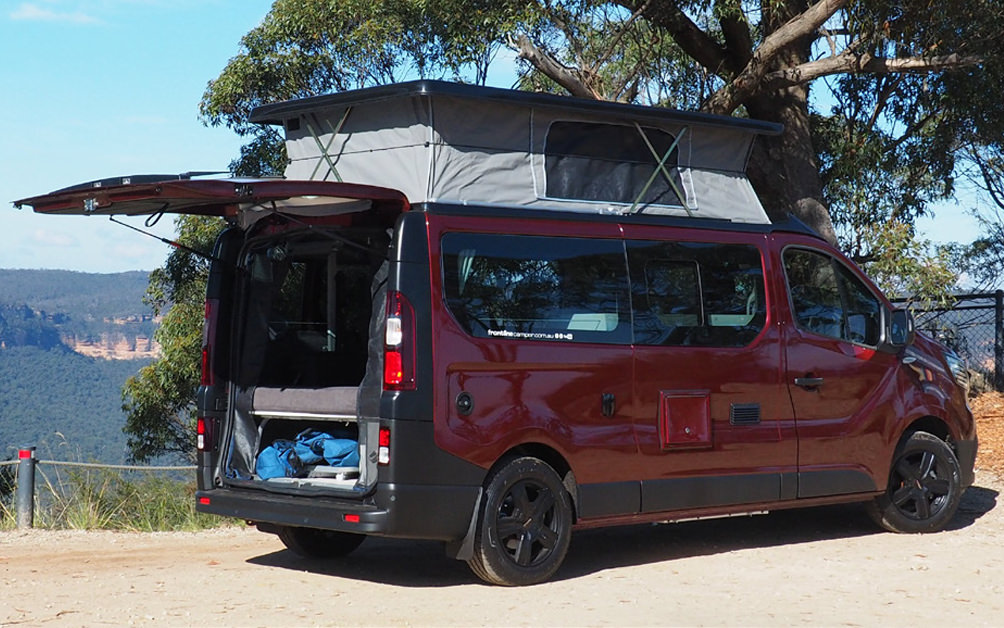
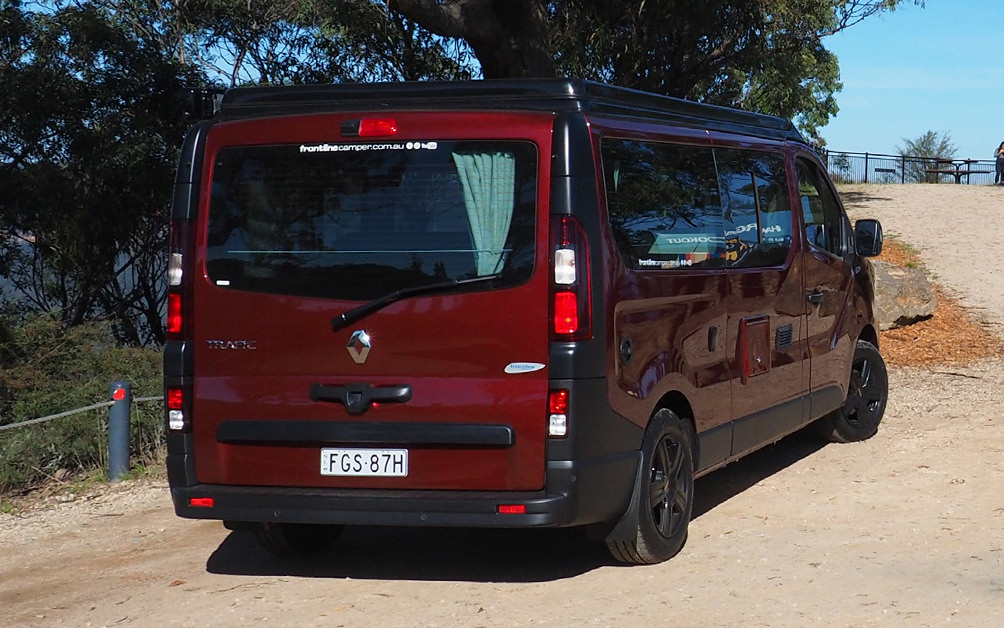
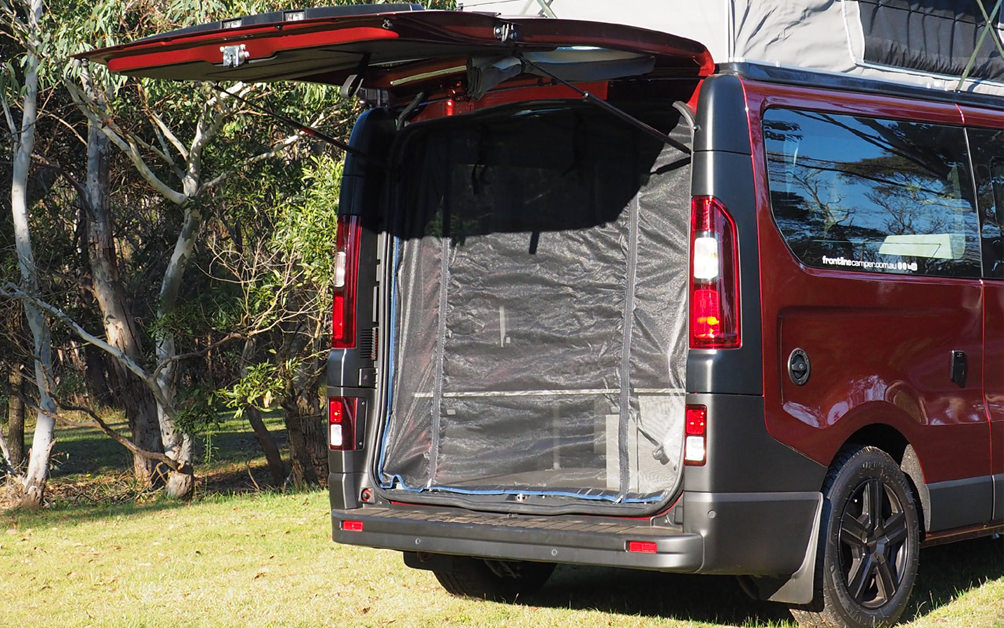
Source: The Wanderer
Written by: Malcom Street
Photography by: Malcom Street
4Motion Adventures road test the Toyota HiAce rear diff-locker
We met with Alex and the team from 4Motion Adventures to test and discuss the latest Frontline Toyota Hiace campervan with a rear diff-locker for off-road terrain.
Frontline Toyota HiAce H30 6 Gen Campervan 2022 Review
User-friendly compact campervan is perfect for first-time van lifers
First-time RV buyers have flooded the market since the pandemic started, driven to road-going holiday escapes by repeated lockdowns and local and overseas travel restrictions.
For those new to RV travel, nothing could be easier or safer to drive for long distances than a compact campervan, especially one based on the popular Toyota HiAce medium van, which doesn’t take up much more space on the road than a seven-seat SUV and is just as stress-free to drive and park.
Sydney-based campervan conversion specialist Frontline was one of the first to convert the latest HiAce van and remains one of few specialists in Australia to offer ‘turn key’ production versions of the top-selling Japanese medium van.
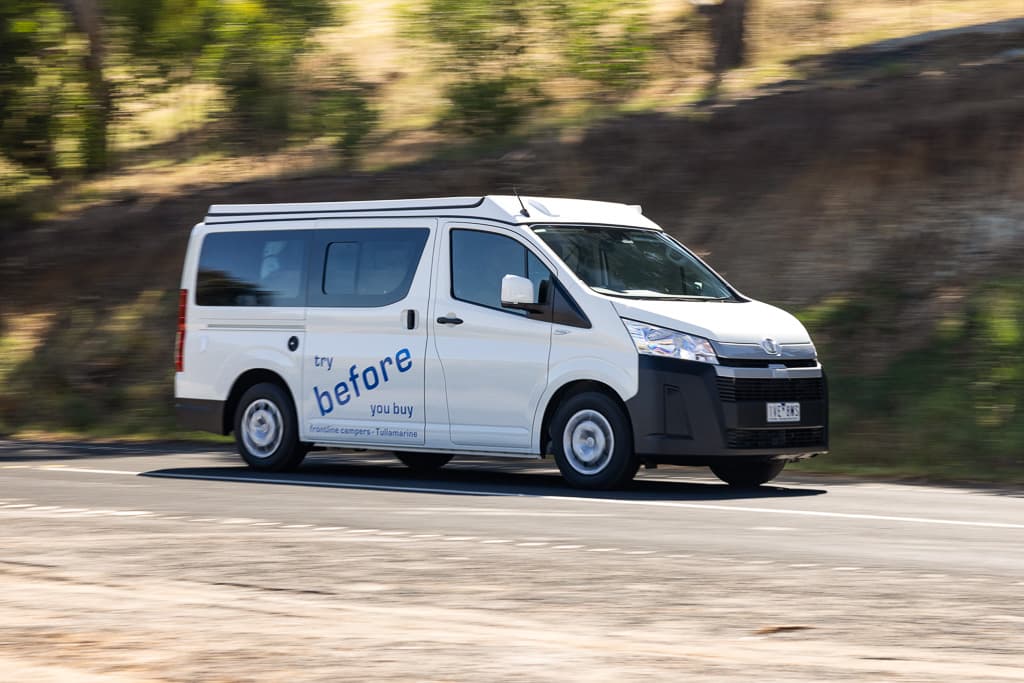
In business for nearly 35 years, Frontline currently builds around three vans a week at its Brookvale factory in north Sydney, based on either HiAce or the slightly more upmarket Volkswagen Transporter.
It also keeps it simple for entry-level campervan buyers, with just a handful of layouts and interior decor options available and a limited number of optional accessories for those who want a bit more comfort or free camping capabilities when touring the countryside.
Ready to roll
Pricing kicks off at $85,500 for Frontline’s HiAce camper, with our ‘try before you buy’ demo vehicle from Frontline’s Melbourne outlet, fitted with the six-speed auto transmission mated to the standard 2.8-litre, four-cylinder turbo-diesel engine, priced at a still reasonable $87,500.

It’s a ‘bog standard’ vehicle, highlighting all the things you get (and don’t get) with a Frontline camper before feeling the need to tick any of the 30-plus option boxes.
“As a van aimed at people just trying out campervanning, we’ve kept this van very simple and haven’t added any options at all,” explained Frontline’s Melbourne manager Jason Magee.
“But it also serves as a great example of the minimum standard inclusions that go into every Frontline camper, even before people look at the options list.”

The review van is fitted out in four-berth ‘Adventurer’ spec — a popular choice among five layouts available — which includes a compact kitchen, external shower and a forward-facing rear bench seat with two seatbelts to go with the driver and passenger front seats.
The rear seating is quickly converted into a double bed at night, and there’s the option of adding a rooftop double bed to turn the van into a somewhat squeezy, four-berth camper.

Our black-bumper review van is based on the cheapest HiAce LWB variant, but you can pay another $1000 for the sleeker GL version with its colour-matched bumpers, door handles, fog lights, and second rear camera.
You can also add side stripes, a front nudge bar and roof racks to jazz up the ‘stealth’ look, although Frontline does an excellent job of retaining the original ‘factory look’ during the camper conversion, including new tinted side windows and a flush-mounted pop-top roof.

SUV-like driving
We weren’t fans of the previous HiAce, cab-over van due to its squishy behind-the-wheel feel, but the latest bonneted version is a big step up in cabin comfort and space, especially for drivers with longer legs.
There’s a clear view out front from the well-cushioned seats, and the rear-drive HiAce impresses with its relatively zippy, refined performance. The 2450kg (unladen) camper gets up to speed quickly in traffic and cruises comfortably on the freeway at 100km/h, thanks to plenty of low-down torque from the diesel engine and smooth, responsive gear changes.

It’s mostly quiet on the move, with the suspension soaking up minor bumps and only the occasional creak or rattle from the living space in the back.
The sharp turning circle makes it easy to squeeze into tight camping spots, with help from the front and rear parking sensors and a reverse camera. Not much larger than the latest LandCruiser, the van’s 2065mm travel height also allows it to slot into the garage at home.
Comfort-wise, the HiAce also boasts a leather steering wheel, air-conditioning, cruise control, and a colour touchscreen with inbuilt sat nav and smartphone mirroring. You also get the reassurance of a five-star safety rating, with disc brakes, seven airbags and vehicle stability control, advancing driving aids like autonomous emergency braking, lane departure warning and a blind spot monitor.

Fuel economy on the trip computer showed around 12L/100km during our test drive, which translates to a theoretical range of about 600km from the 70-litre fuel tank.
Simple set-up
The Frontline HiAce Adventurer also boasts flat-floor, walk-through access from the front seats to the living area, which means you don’t have to go outside to set it up if it’s cold or raining, with the pop-top roof raised from inside.
The main outside entry is through the onside sliding door, or if you’re feeling athletic, you can jump up onto the raised lounge/bed after lifting the top-hinged tailgate. The raised tailgate doubles as another shade cover with the Fiamma wind-out onside awning.

Raising the roof manually from the inside couldn’t be easier after undoing a strap in each corner, and there’s excellent standing room throughout, thanks to the sizeable pop-top roof.
There’s also plenty of natural light and ventilation available thanks to three flyscreen windows in the pop-top canvas and another sliding door and small sliding window on the offside that opens up for more cross-breeze ventilation.
However, you’ll pay more for optional, removable zippered flyscreen panels for the rear tailgate and sliding doors ($380 a pop), which will help keep the bugs out on balmy nights.
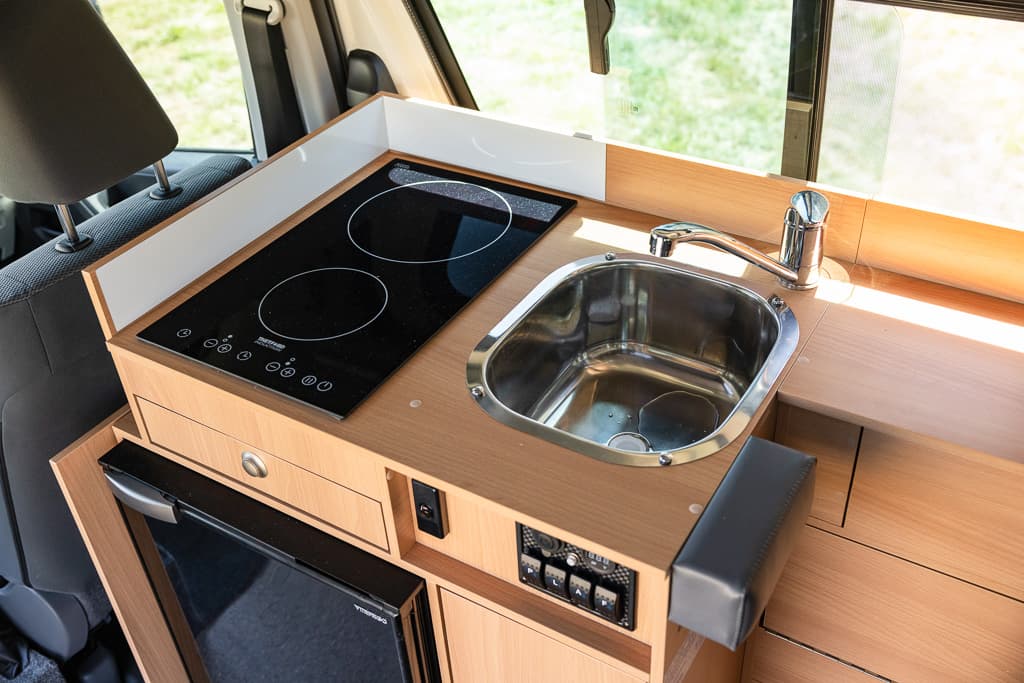
Externally, there’s a socket to plug into 240V power at a caravan park and an inlet to fill the 50-litre fresh water tank. A 22-litre grey water tank is optional.
There’s also a tiny external locker to carry spare bottles for the portable butane cooker that comes standard with the 240V induction cooktop, so you can heat things when free camping. Buyers can opt for a $1500 two-burner gas cooktop instead of the induction cooktop, with the larger gas bottles stored in the boot.
Accessible inside and out, the primary storage space in the rear ‘boot’ is large enough to carry the camp chairs, cords, hoses, a few tools and a portable toilet. Another option is a dedicated under-bed compartment for the porta-Potti, to make it easier to access and use at night.
Camping conveniences
The Frontline camper comes standard with a single 100Ah AGM battery and Victron 12V/15 smart chargers, which are located in the rear boot space, along with a solar regulator and Anderson plug so you can plug in an optional solar panel when off-grid camping.
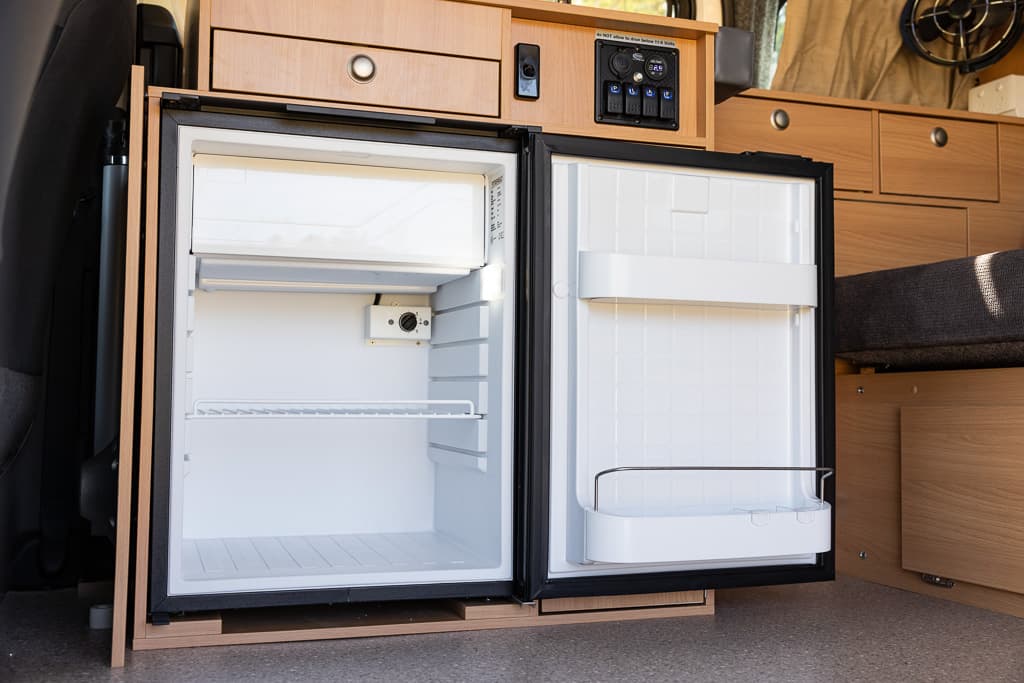
The battery should run the fridge, lights, water pump and fan for a day or two before recharging. You can pay more for another AGM battery or an up to 200Ah lithium battery system and 2000W inverter that will run the induction cooktop outside caravan parks. Still, the bulkier components will eat into valuable storage space in the rear boot.
The compact kitchen has a two-hob induction cooktop and stainless steel sink module behind the driver’s seat, with a 75-litre compressor fridge/freezer below. There’s an aluminium protective shield and light above the cooker, but no rangehood, so you’ll need to open the doors and windows to allow the cooking odours to escape.
For food prep, there’s the option of a narrow strip of benchtop on the right of the sink, an above-cab shelf up front, and a removable dinette table.
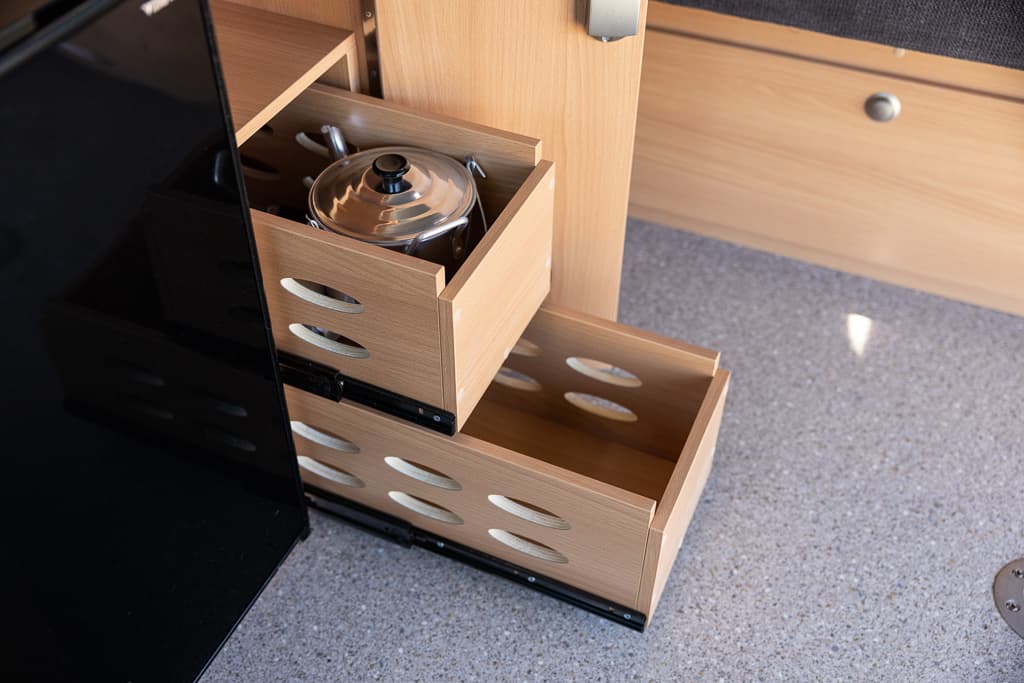
The tabletop and leg are stored behind the driver’s seat and slot easily into place for meals, with further adjustment thanks to a swivel-top and an optional base available to use the table outside. The front passenger seat also swivels around 180 degrees to face the living area when camping.
Pulling a couple of levers quickly converts the ‘Rock and Roll’ lounge/bed into a flat mattress for the night (or day!) use, although you’ll need to store the linen separately when in ‘seating’ mode. The foam cushion bases are comfy, but the 1860mm x 1400mm double bed could be too cosy for two larger adults. If that’s an issue, Frontline offers other layouts with a slightly larger bed.
There’s also the option to slot in a 90kg-rated rooftop bed above the main bed to accommodate a small child or two.
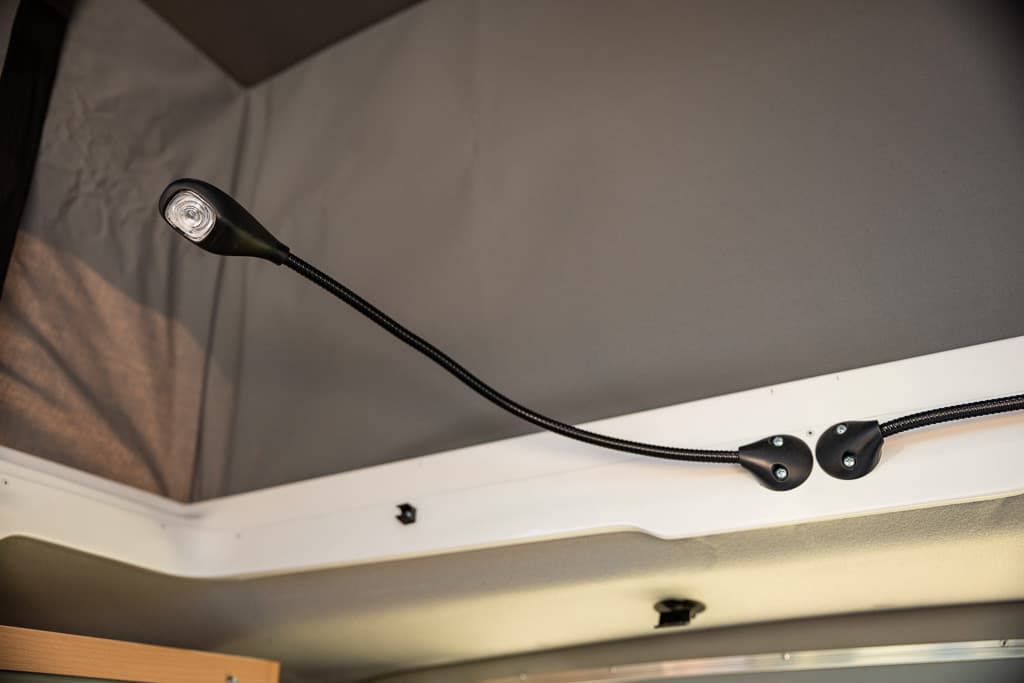
Other on-the-road comforts
Cold showers are outside, using the retractable shower hose with a faucet accessible from under the rear tailgate. If you plan to travel in cooler months, an optional ($2300) 240V heat exchange unit is available for warmer showers.
The interior also has a good array of 240V, 12V and USB sockets for powering a few gadgets, including a 12V socket in the control switch panel located under the kitchen bench. There are also some LED roof lights, flexible stork reading lights, and a single 12V swivel fan.

There are block-out curtains on all windows and the front driving cabin windows, so the swivelled passenger seat remains within the camper space once you’ve closed up for the night.
There’s no option to fit an RV air-conditioner, but buyers can add a diesel space heater, microwave and TV, and canvas outside ‘rooms’, although the more stuff you fit, the less dedicated storage space you’ll have. However, there’s more than enough payload at 850kg, and you can tow a trailer up to 1500kg with the auto transmission.
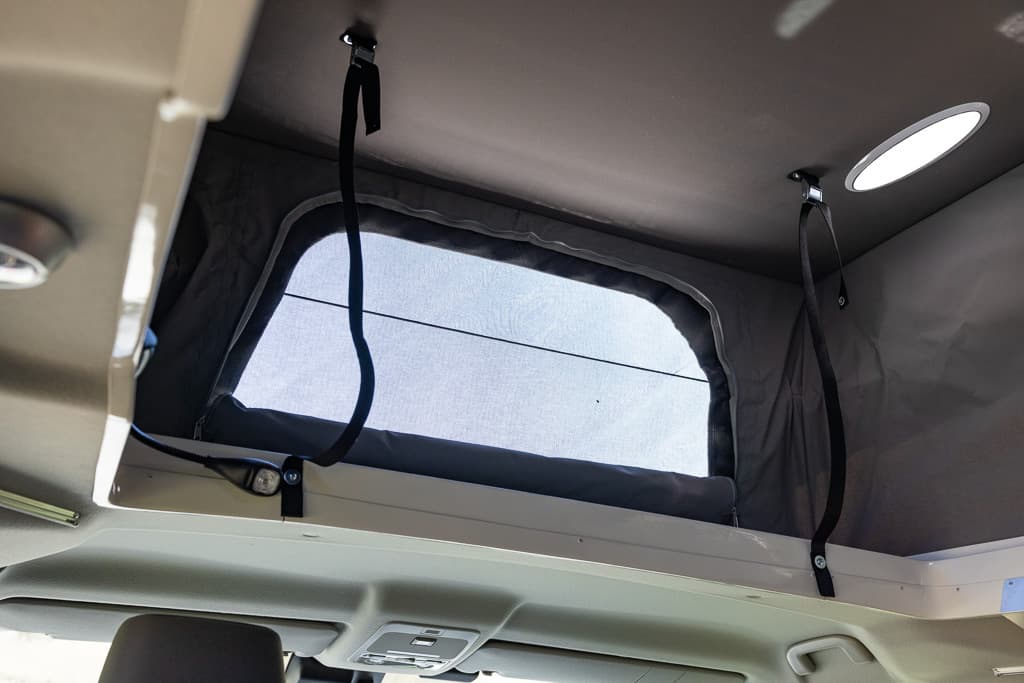
There’s a surprising number of (compact) storage options inside, built into the light ply cabinetry on the offside wall, including six small drawers and cupboards around the kitchen and a good-sized cupboard/wardrobe alongside the bed for clothes and towels.
Frontline offers a limited palette of interior colour options. The review van sporting a more traditional look of beech ply cabinets, Baltic blue cloth upholstery, sand curtains and pebble lino.
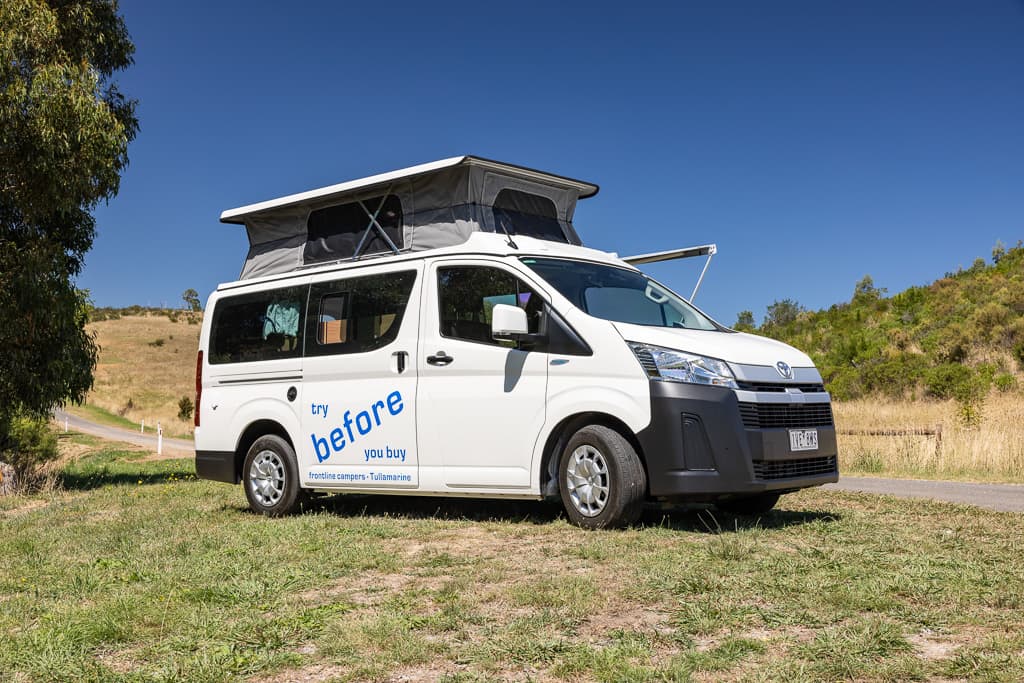
Summing up
While it may lack the ‘bling’ of some of its rivals, the Frontline HiAce Adventurer is hard to fault as a well-designed, practical and user-friendly campervan. It all looks built to last, using lightweight, durable materials, including marine-style carpet and moisture-resistant furniture ply.
Depending on your needs and budget, you might want to add a few options, like hot water and removable fly screens for the entry doors. Still, otherwise, it’s an appealing, affordable entry-level campervan that doubles as a family-friendly daily driver when you’re not on holiday.
How much does the 2002 Frontline HiAce Adventurer cost?
Price: $87,500
Base vehicle: Toyota HiAce LWB Auto
Licence: Car
Tare: 2450kg (approx.)
GVM: 3300kg
Towing capacity: 1500kg
Occupants: Four seatbelts, two berth
Travel length: 5265mm
External body width: 1950mm
Travel height: 2065mm
Interior height: 1970mm
Engine: 2.8-litre four-cylinder turbo-diesel
Power/torque: 130kW/450Nm
Transmission: Six-speed automatic
Fuel tank: 70 litres
Wheels: 16in steel
Brakes: Discs (fr and rr), ABS and ESP
Cooktop: Thetford 240V two hob induction, plus portable butane cooker
Fridge/freezer: Vitrifigo 75-litre compressor
Microwave: Optional
Lighting: 12V LED
Battery: 100Ah AGM and 240V charger
Solar: Portable or rooftop panel optional
TV: Optional
Air-conditioner: NA
Shower: Rear pull-out hose with 12V cold tap
Toilet: Portable optional
Freshwater: 50L
Gas: Optional
Hot water: Optional
Credit: Caravan Camping Sales
https://www.caravancampingsales.com.au/editorial/details/frontline-hiace-2022-review-134626
Toyota Hiace Campervan Review by Time to Roam
We’ve been waiting a while, but the new Toyota HiAce campervan from Frontline was worth it.
Toyota knows how to keep a crowd waiting. When the latest HiLux was launched in 2015, it had been 11 years since the last new one. The LandCruiser 200 Series has been on sale since 2008. But the previous HiAce takes the cake — it was on sale for 15 years before being updated late in 2019. It had been around so long only a few campervan manufacturers were still working with the platform. The rest had moved to more modern vehicles like the Hyundai iLoad or tried-and-tested VW Transporter.
But not Frontline. Until the very end, its HiAce camper conversions had found a dedicated market of travellers who didn’t need flash. They just wanted comfortable, dependable and unassuming recreational vehicles that didn’t cost the earth. Now that there is a new HiAce, Frontline has spent the last eight months developing a new range of campers to suit. Over two days exploring the south coast, I checked out the first version, a two-seater with a semi-permanent bed.
Toyota had 15 years of technology and consumer sentiment on safety to consider. The new Toyota HiAce H30 6 Gen Campervan is significantly better than the outgoing model. No more do you sit over the engine and rely on the slimmest of vehicle crumple zones for safety. With the engine out the front and a slew of other upgrades, the new van attained a five-star ANCAP safety rating (the current VW Transporter — the T6 — hasn’t been tested, but the T5 was rated four stars). But it’s more than just a bit of extra cushioning. Each Hiace comes with seven airbags for the two front passengers, a pre-collision safety system capable of hitting the brakes if you fail to, blind-spot monitoring and even a road sign recognition function that warns you if you’ve gone past a sign faster than it indicates. A friendly voice reminds you to obey local road regulations. Above that, the model I tested has an active lane-keeping function that turns the vehicle back into its lane if I let it drift out. It feels like getting hit by a gust of wind, but it works.
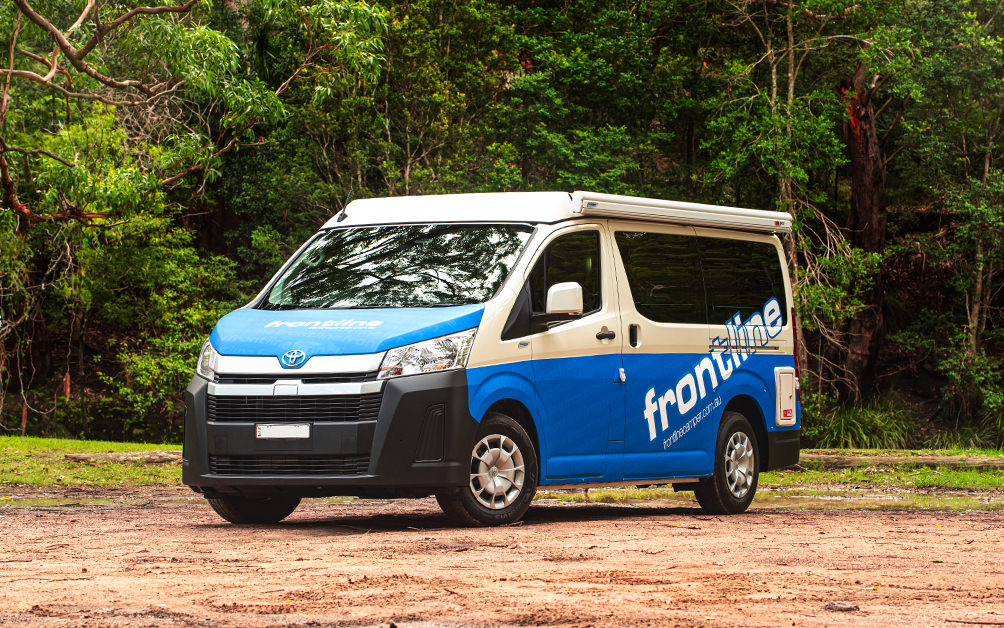

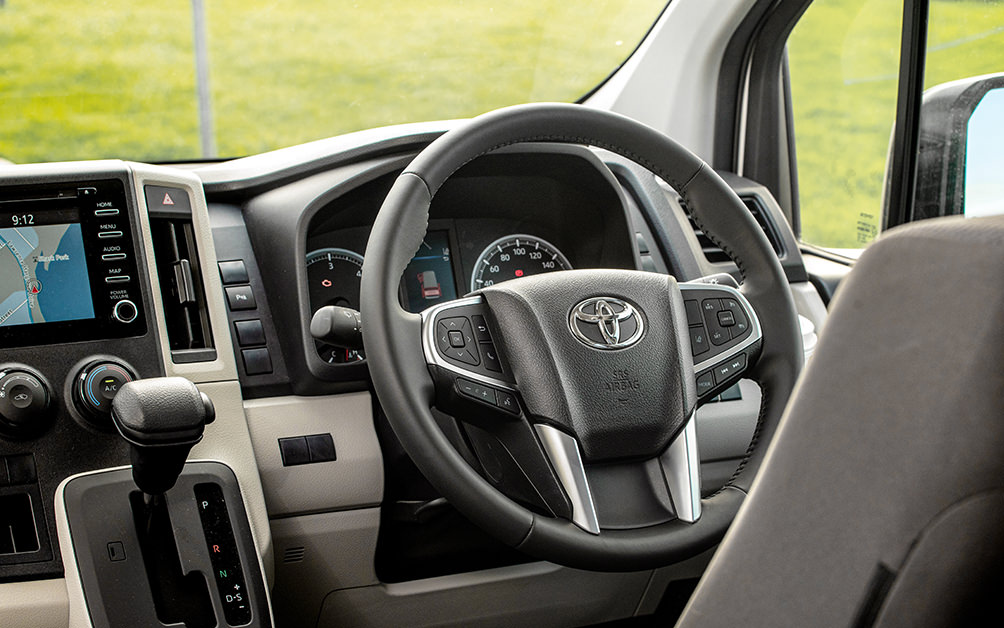
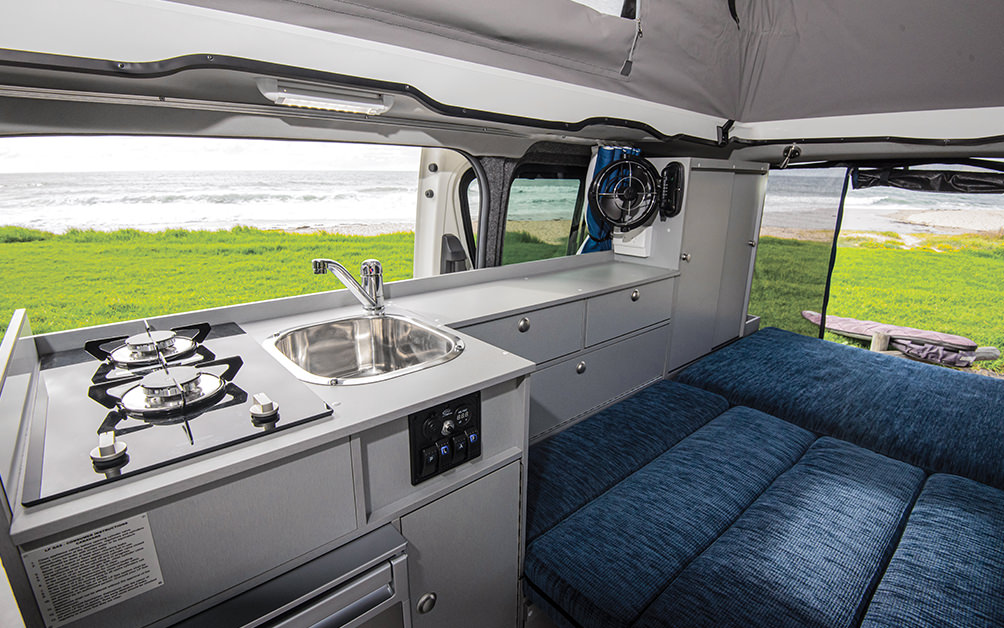
There are two engine options available; a 3.5-litre V6 with 207kW and 360Nm, or the same 2.8-litre found in the HiLux, which produces 130kW and 450Nm.
The latter is expected to be the more popular option, and paired with a six-speed auto, is what I’m testing. It used just less than 11L/100km while I had it.
To drive, it’s pretty good, especially compared to the older commercial model. In the cabin, it’s quiet and smooth, and a modern dash and steering wheel puts everything within easy-to-use reach. As for comfort, VW still has a slight edge, especially in the seats, but the gap has significantly narrowed.
But we’re here for the camping, so what’s the conversion like? Frontline has made many changes with the new vehicle, mainly because the van is slightly shorter but broader in the load area. It also has a walk-through cabin and a narrower entry through the sliding door.
Popping the top is as simple as it’s ever been. All the catches are inside, so you don’t have to go outside to make it happen. Once they’re undone from the interior shelter, a simple push opens it all up. It might not seem like much, but Frontline spent months developing just this part of the van.
Because you can walk from the driver’s cabin into the living area of the van, and the front passenger seat swivels, the new camper is much more spacious than previous Frontline Hiace campers I’ve tested. That front seat is easily the best place to relax, but it also means there’s more room to shuffle around as you cook in the kitchen or hop in and out of the van.
The kitchen is a significant change for Frontline.
For a long time, its vans used a methylated spirit stove in a drawer, which could be quickly taken out for cooking outside. When Dometic stopped making them last year, Frontline moved to a high-quality, two-burner butane stove for that portability but has fitted a Truma two-burner gas hob in the HiAce, set into the benchtop. We can vouch for the furnace — we’ve got the same held in our old Viscount, and it’s certainly a more elegant, easier-to-use solution than metho or expensive butane canisters ever were. The fridge is also new. Frontline’s traditionally fitted Engel upright fridge-freezers to its vans, but the move to Dometic’s 80-litre upright is good. I’ve always found them reliable, high-quality units, which don’t make as much noise when they cycle at night as the Engels do.
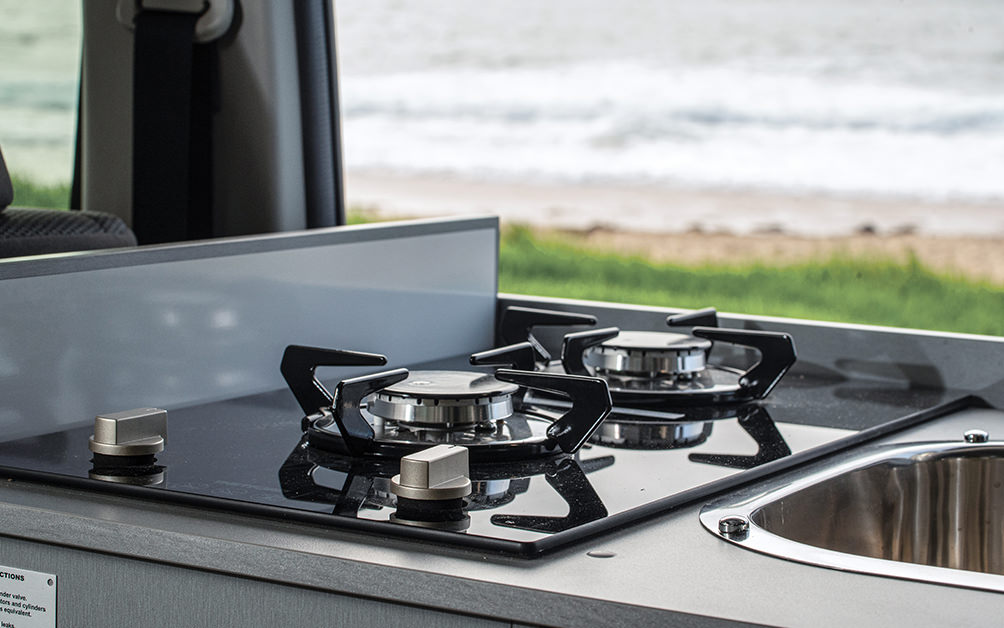

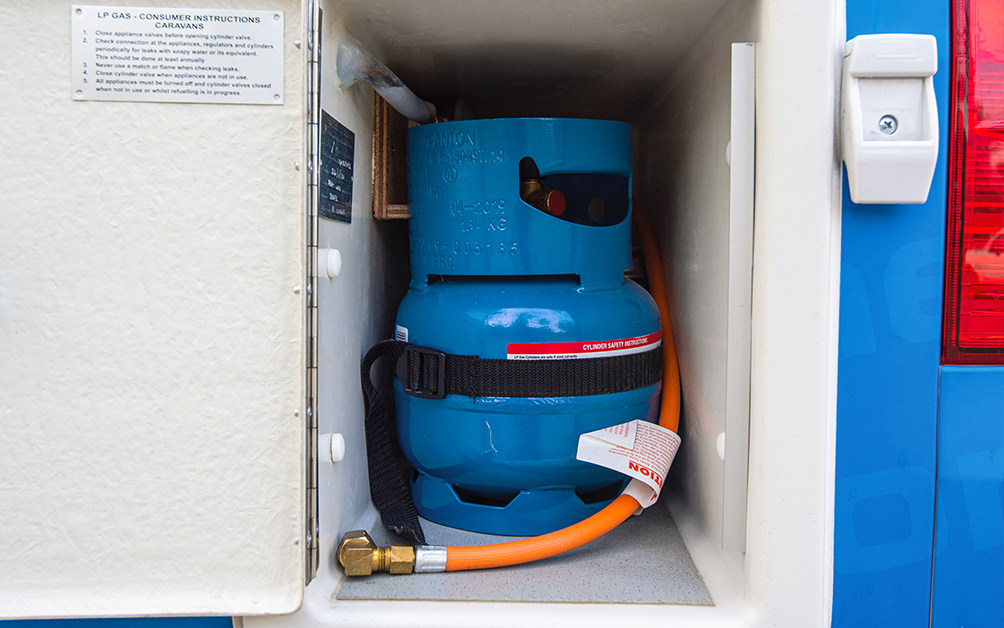
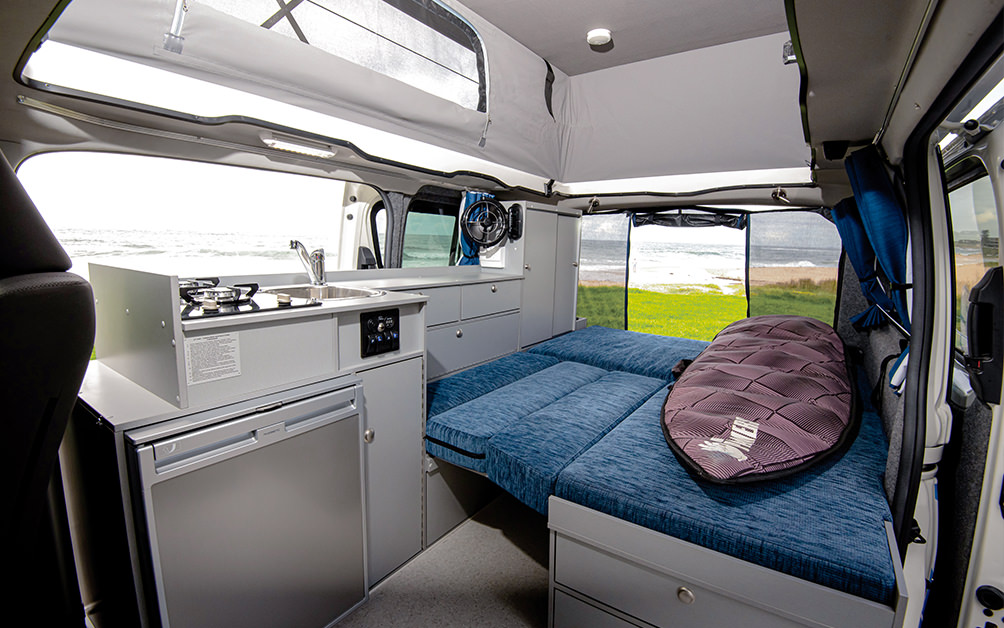
Typically for Frontline, the storage around the kitchen is excellent, with just about every available space used for drawers, cabinets or hidey-hole.
It’s here you get to appreciate Frontline’s cabinetry work as it’s just behind the driver’s seat, but there was no squeak, rattle or annoying noise from it when I drove. The only noise from the back was the occasional slap of a curtain on the driver’s side sliding door, which I could have fixed if it was an issue. I did like that there’s a sliding door on each side, as opening it up behind the kitchen helped get a breeze through, not to mention the view.
The camper’s bed is an evolution of Frontline’s ‘Avalon’ layout, where the bed converts to a club-style lounge with a table that can sit in the middle. Given that the van is so much more expansive, it’s allowed the fitment of an extra cabinet down the side, seen in former Vacationer and Adventurer models. Keeping it all very simple, the table and an extra timber square are all needed to fill the gap to make a bed. And the ample, flat space is much longer than I’ve managed to make it seem in the pictures (it’s at least 6’4″ because that’s how long my surfboard cover is.
There’s plenty of storage under the rear bed. Two drawers slide out neatly into the main entryway while various cushions lift to reveal more cabinets underneath. The back half of the bed sits over a boot, the largest dedicated storage area in the van. It’s big enough for camp chairs, extra awning walls or other bulky gear.
Although simplicity is evident throughout the camper, it’s still fitted with all modern needs.
A 100Ah battery sits under the bed, charged automatically when driving. It can be expanded to a second battery or with solar panels on the roof. Frontline specifies a 50-litre water tank, but hot water is only an option. That’s because hot water tanks are bulky and take 20 minutes to heat up, whereas you have to bring a kettle anyway. All the lights through the camper are LED, and there are USB charging points at the kitchen, along with 240-volt outlets for when you have power, At the back, there’s a cold-water shower, perfect for rinsing things off.
Overall, this is a great new camper. Too good, almost. For a few thousand dollars less, you can get a Frontline converted Volkswagen Transporter with the little, 103kW engine. Unless you wanted a specific layout that’s not yet available in the HiAce, there’s no way you’d bother. Even the more expensive 132kW VW doesn’t look quite the value this new model does. The safety, comfort, drive and layout of the new Toyota are just so good now that it’s a close game. For me, unless I needed AWD, I think the van from Japan is the best value camper in the range.
THE BASIC FEATURES
Frontline Toyota Hiace 6th Gen
CHASSIS
Vehicle — Toyota HiAce
Engine — 2.8-litre, turbo diesel
Transmission — 6-speed automated
Power — 130kW
Torque— 450Nm
Fuel Economy — Around 11L/100km
DIMENSIONS AND WEIGHTS
Length — 5265mm
Width — 1950mm
Height — 2065mm
Headroom — 1970mm
GVM — 3300kg
Towing — 1900kg
CAPACITIES
Water — 50L
Grey Water — Optional
Fridge — Dometic, 80 litres, compressor
Battery — 1 x 100Ah AGM
Fuel — 70L
WARRANTY
Toyota —5 years, 160,000km
Frontline conversion — 2 years
From $72,000 drive-away. As tested
(diesel, auto) from $78,000 drive away.
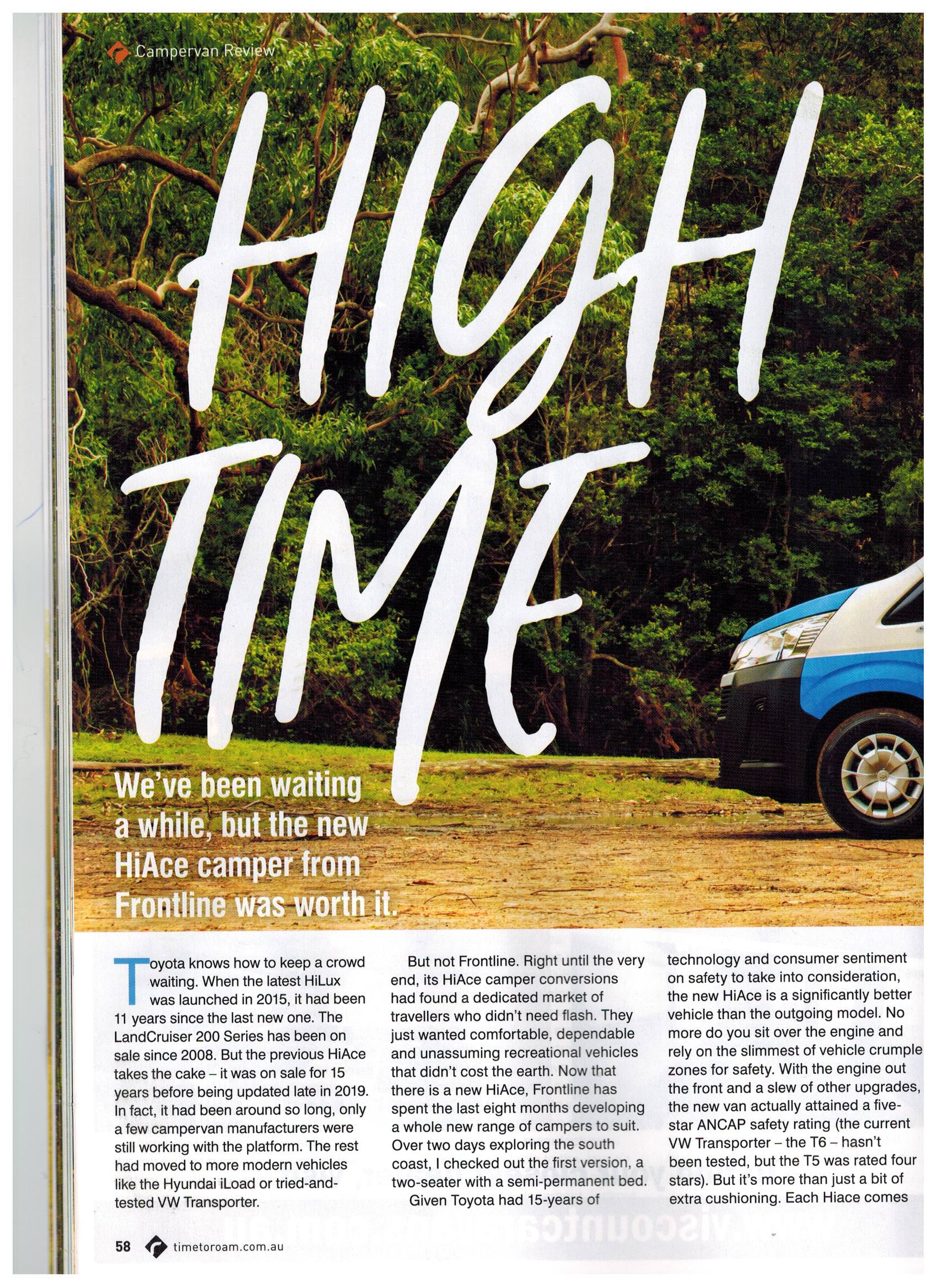


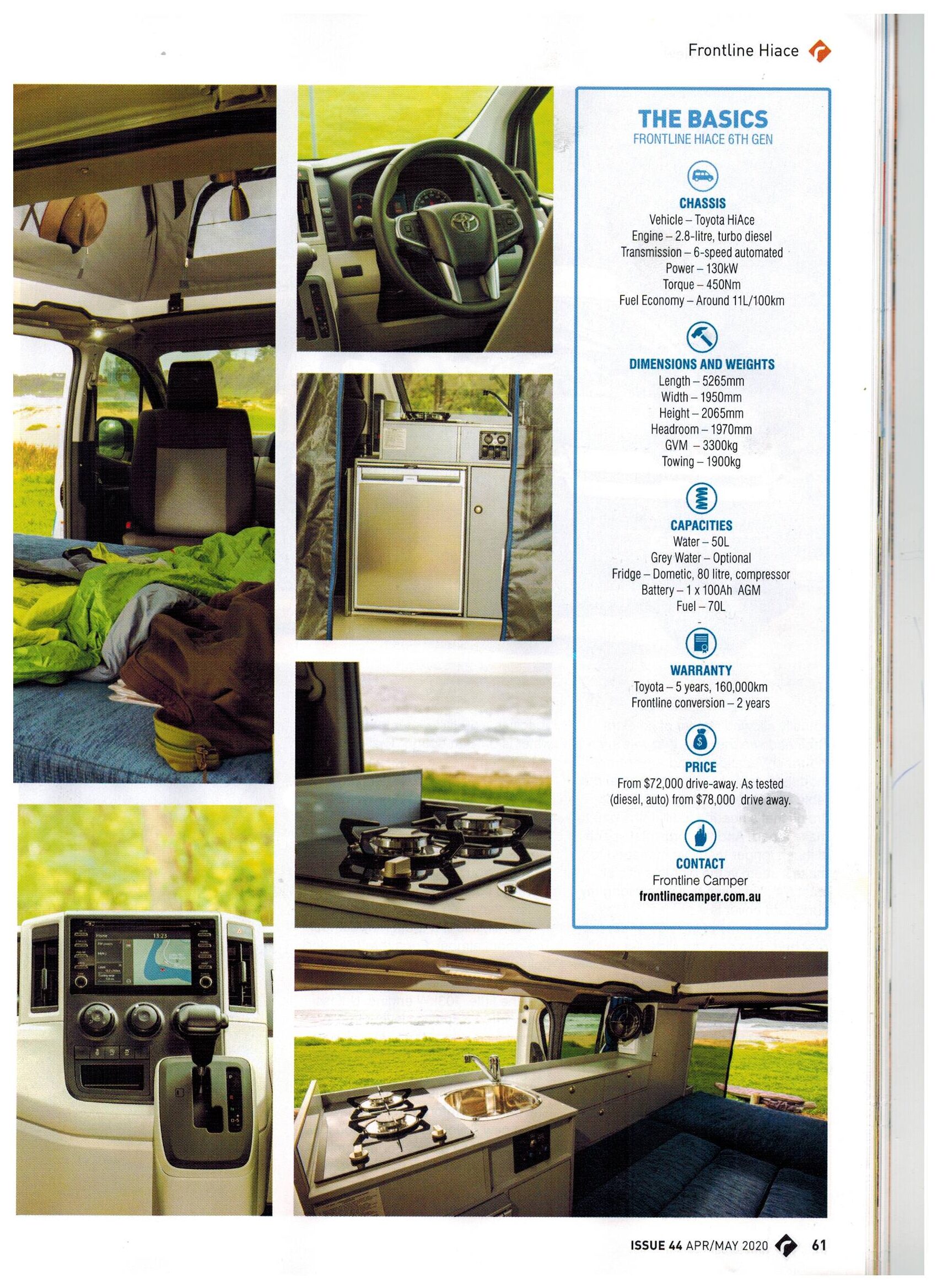
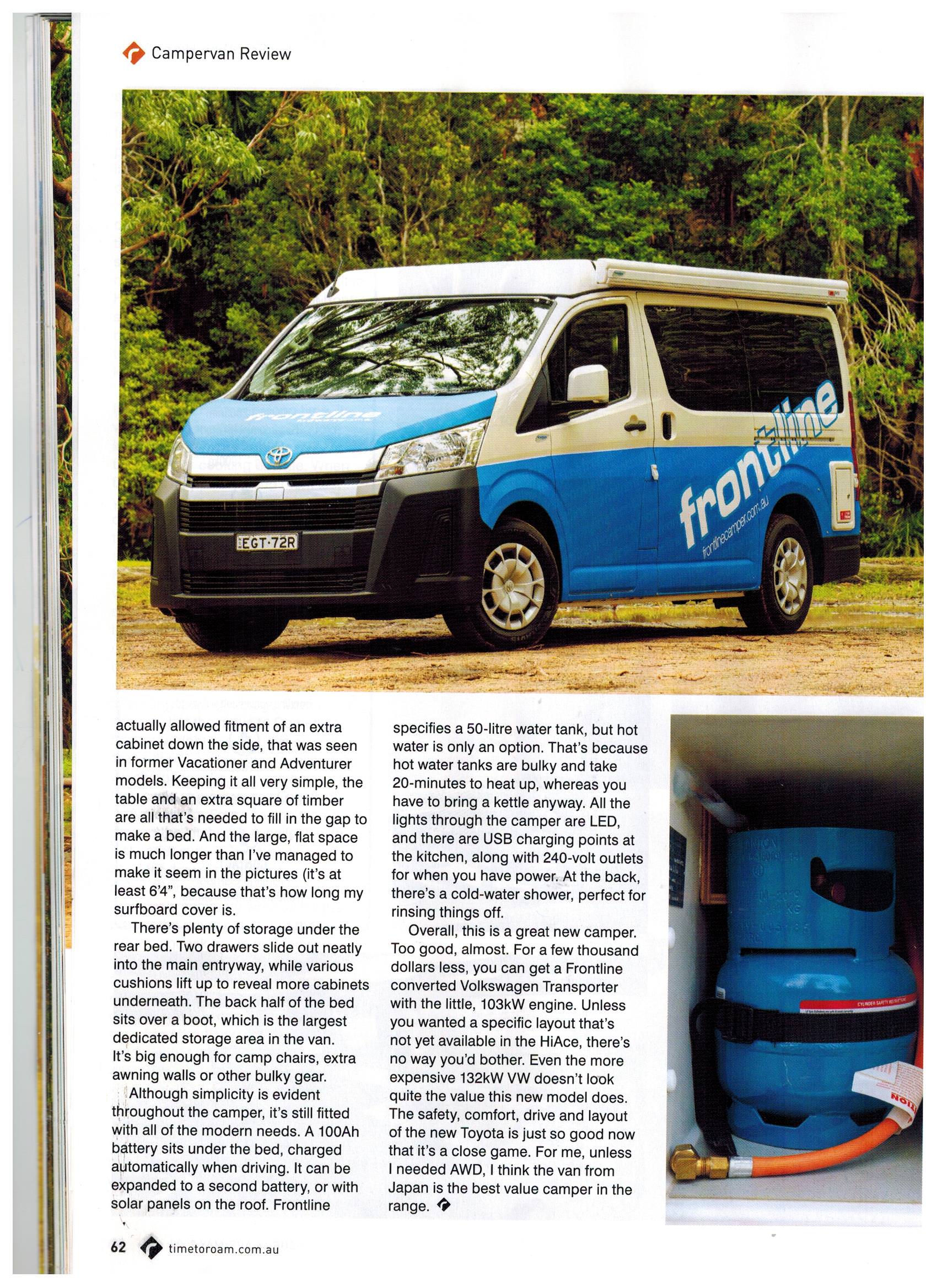
Credit: Time to Roam